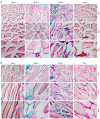Microenergy acoustic pulse therapy restores function and structure of pelvic floor muscles after simulated birth injury
- PMID: 35693721
- PMCID: PMC9177267
- DOI: 10.21037/tau-22-30
Microenergy acoustic pulse therapy restores function and structure of pelvic floor muscles after simulated birth injury
Abstract
Background: The mechanisms of the microenergy acoustic pulse (MAP) therapy on restoring structure and function of pelvic floor muscles (PFM) after simulated birth injury are not well understood.
Methods: A total 24 female Sprague-Dawley rats were randomly grouped into sham control (sham), vaginal balloon dilation and ovariectomy (VBDO), VBDO + β-aminopropionitrile (BAPN, an irreversible LOX inhibitor), and VBDO + BAPN and treated with MAP (n=6 in each group). The MAP therapy was administered 2 times per week for 4 weeks with 1-week washout, the functional and histological studies were conducted in all 24 rats. The viscoelastic behavior of the PFM, including iliococcygeus (IC) and pubococcygeus (PC), was examined with a biomechanical assay. The structure of the PFM was assessed by immunofluorescence and Masson's trichrome staining.
Results: The leak point pressure (LPP) assay demonstrated that the MAP therapy group had higher LPPs compared to that of VBDO and BAPN groups. In the sham group, the muscular stiffness (K) of IC muscle was significantly higher than that of PC muscle while the pelvic floor muscle rebound activity (MRA) of PC muscle was stronger than that of IC muscle (291.26±45.33 and 241.18±14.23 N/cm2, respectively). Both VBDO and BAPN decreased the MRA and increased the K in both IC and PC. Histologic examination revealed increased fibrous tissue (collagen) and degeneration of muscle fibers in both VBDO and BAPN groups. MAP therapy significantly reduced the collagen content and improved the architecture of muscle fibers.
Conclusions: MAP appears to restore the structure and function of PFM by regenerating muscular fibers and improving biomechanical properties in an animal model of simulated birth injury.
Keywords: Microenergy acoustic pulses (MAP); pelvic floor muscles (PFM); stress urinary incontinence (SUI); vaginal balloon dilation and ovariectomy (VBDO); β-aminopropionitrile (BAPN).
2022 Translational Andrology and Urology. All rights reserved.
Conflict of interest statement
Conflicts of Interest: All authors have completed the ICMJE uniform disclosure form (available at https://tau.amegroups.com/article/view/10.21037/tau-22-30/coif). TFL serves as an unpaid Editor-in-Chief for Translational Andrology and Urology. GL serves as an unpaid Editorial Board Member from August 2020 to July 2022 for Translational Andrology and Urology. YZ is the founder and CEO of HillMed Inc. and BrainHealth Tech Inc. TFL is a consultant, co-founder and investor of Acoustic Wave Cell Therapy, Inc. The other authors have no conflicts of interest to declare.
Figures






References
-
- Urogynecologic Surgical Mesh Implants FDA.. 2019. Available online: https://www.fda.gov/medical-devices/implants-and-prosthetics/urogynecolo...
